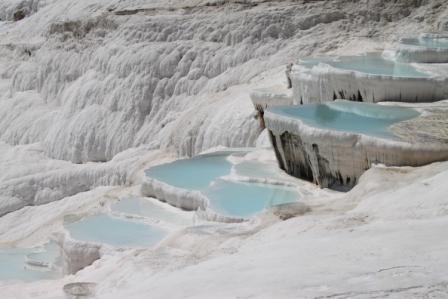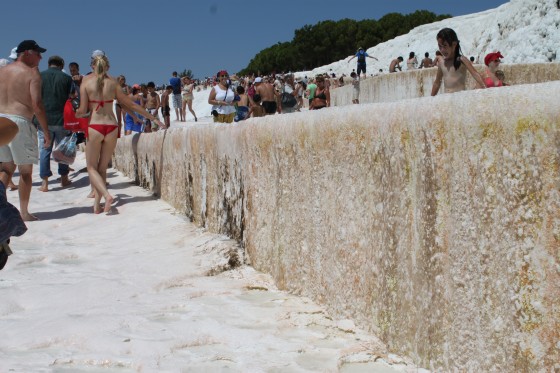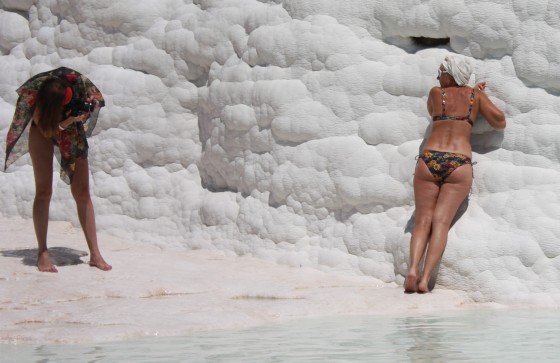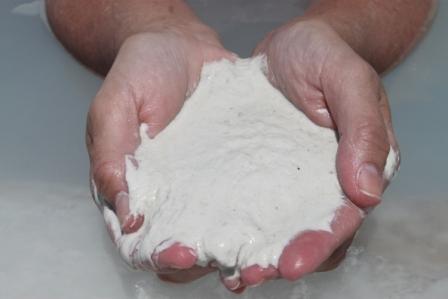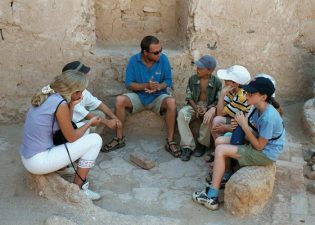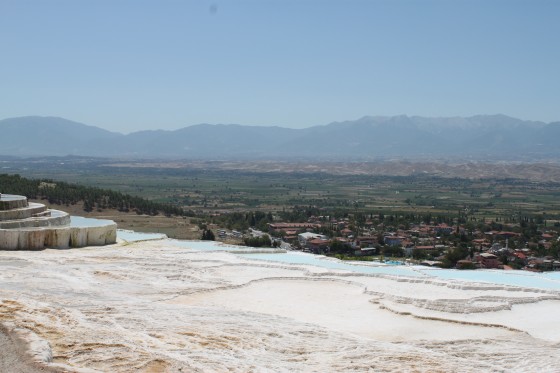 Pamukkale is the most sensual and surreal of Turkey’s eleven World Heritage sites.
Pamukkale is the most sensual and surreal of Turkey’s eleven World Heritage sites.
Seventeen natural hot springs pour a continual stream of mineral water down the enormous travertine steps of Turkey’s Pamukkale. It’s a Dali painting come alive. Rock formations melt like liquid stairs dropping from hilltop Hierapolis towards the surrounding skirt of farmland. It’s located in Turkey’s Inner Aegean region, in the River Menderes valley, near the town of Denizli.
For over 14,000 years, the calcium carbonate (CaCO3) dissolved in the waters have coated this outcropping in a sparkling white icing.
CaCO3 is the main ingredient in pearls and eggshells and it supersaturates these turquoise waters.
I went to have a look for myself.
The ancient ‘hot tubs’ meld archeology with earth sciences to create a gorgeously surreal environment.
The water has therapeutic qualities and has been used since antiquity to treat eye and skin diseases, high blood pressure and heart disease. People have bathed here for millennia and tourism is strong.
Imagine a giant bookshelf collapsing and the characters in every story and poem escape from their pages and run off to play. That’s the scene at Pamukkale, where an international cast with clashing cultures convene in puddles of warm mineral water.
Groups of tanned Greek men grease up and strike Herculean poses for one another, while western babies splash about in Sponge Bob swimmies.
There are women in full Islamic dress rubbing warm carbon mud on tiny windows of exposed face.
Russian girls wrapped in dental floss swimwear stand spread-eagled across the brilliantly white walls. They smile seductively over their shoulders at camera-fumbling boyfriends, waiting for their Playboy close-up. I should’ve taken photos of those photos being taken: behind each shutterbug lover were dozens of other men sneaking their own snaps of the not-so-private pinup postures.
 Very large Eastern Europeans coat one another in a calcium schmear and loll in shallow pools like a bloat of hippos. Yes, I did say loll.
Very large Eastern Europeans coat one another in a calcium schmear and loll in shallow pools like a bloat of hippos. Yes, I did say loll.
Which pretty well describes what I did, solo, when my family quickly abandoned me.
They’d spent an hour wading, taking photographs, and scooping up the soft white ooze from the bottom of the turquoise pools. But a dirty bandage hidden in the mud spoiled their Kodak Moment and they retreated to a shady cafe to wait out my float.
They could’ve left me with a few books to read and come back in a week. I love this place.
I found an empty pool, which was surprisingly easy. Most people do like my kids did: test the waters, take loads of pictures, then head for shade to cool off and review their photography. Pamukkale is fantastically photogenic. Few visitors actually hang around for a soak.
The water was lovely, about 39 degrees. Disturbed calcium sediments make it milky and gorgeously green-blue.
 The hardened CaCO3 makes for a lethal crust. People walk gingerly around individual ponds and carved water channels to avoid faceplants and spills.
The hardened CaCO3 makes for a lethal crust. People walk gingerly around individual ponds and carved water channels to avoid faceplants and spills.
But the sediments that coat the bottoms of each pool are powder-fine and, mixed with the water, they form a soft paste much like pancake batter. Japanese tourists were scooping it into empty water bottles. Wonder if the muck could make it through airport security?
This water was a wonderful change from the salted buoyancy of the Dead Sea (my hometown mineral bath) but shallow depths make for more of a “sit” than an actual float.
This might be another reason folks pass on taking a plunge, there’s not much to do in the pools once you sit down.
Except maybe take pictures, and in turn, be photographed. (In the interest of fairness, I also appear somewhere in these pictures).
Hot springs exist throughout the Middle East. The Lonely Planet describes Tiberias hot springs near the Sea of Galilee in Israel and Evason Ma’In hot springs near the Dead Sea in Jordan: modern resorts with swanky spas. Public bathing is on offer at Jordan’s Hammamat Ma’in, a Wadi Zarqa Ma’in resort where the mineral water’s collected in communal swimming pools.
Pamukkale is unique in that you can freely experience the spring waters at source, in its splendid natural setting, without gender segregation, dress code restrictions or serious damage to your wallet. Modern Turkey’s relative tolerance plays large in the positive Pamukkale experience.

